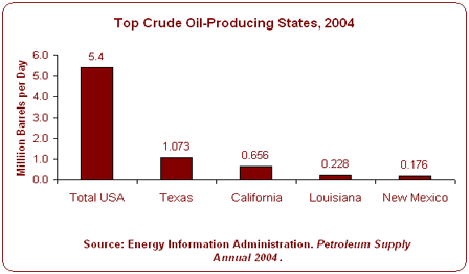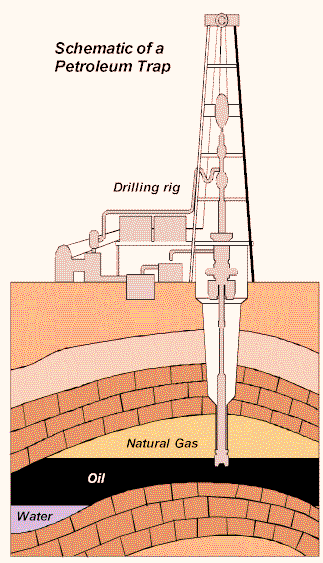Crude Oil Background
 Crude oil, a malodorous yellow-to-black liquid, is a product of the decayed remains of prehistoric marine animals and terrestrial plants. Over many centuries, organic matter in mud was buried under additional thick sedimentary layers. Additional sedimentary layers, the increasing heat and pressure caused crude oil-saturated shales to form, from which the oil was expelled. It then moved through adjacent rock layers until it became trapped underground in porous rocks called reservoirs.
Crude oil, a malodorous yellow-to-black liquid, is a product of the decayed remains of prehistoric marine animals and terrestrial plants. Over many centuries, organic matter in mud was buried under additional thick sedimentary layers. Additional sedimentary layers, the increasing heat and pressure caused crude oil-saturated shales to form, from which the oil was expelled. It then moved through adjacent rock layers until it became trapped underground in porous rocks called reservoirs.
Drilling a well to extract crude oil is a complicated process, but it is the only way to confirm the existence of oil. After initial exploration activities, site preparation begins. The type of rig system to be used, whether rotary or cable, is determined.. When completed, the drilled well has been turned into a production facility capable of bringing a steady flow of oil to the surface, usually for many years. While getting the oil out of the ground may seem complicated, moving it from the point of production to the final consumer is just as complex. Today, there are more than 160,000 miles of oil pipeline in the United States.
In 2004, total domestic crude oil field production , including Federal offshore, averaged 5,419,000 barrels per day, a decrease of 262,000 barrels per day from the 2003 average. The top crude oil-producing States are Texas, Alaska, California, Louisiana, and New Mexico.
 The United States and Russia, along with the Organization of Petroleum Exporting Countries (OPEC), accounted for 61 percent of the total crude oil produced in the world in 2004. The United States accounted for 7.4 percent of the world's total 2004 crude oil production, and Russia 12 percent. Because uses for crude oil in its natural state are limited, almost all crude oil is processed into finished petroleum products at a refinery. The refining process usually involves (1) distillation, or separation of the hydrocarbons that make up crude oil so that the heavier products, such as asphalt, are separated from the lighter products, like kerosene; (2) conversion, or cracking of the molecules to allow the refiner to squeeze a higher percentage of light products, such as gasoline, from each barrel of oil; and (3) treatment, or enhancement of the quality of the product which could entail removing sulfur from such fuels as kerosene, gasoline, and heating oils. The addition of blending components to gasoline is also a part of this process.
The United States and Russia, along with the Organization of Petroleum Exporting Countries (OPEC), accounted for 61 percent of the total crude oil produced in the world in 2004. The United States accounted for 7.4 percent of the world's total 2004 crude oil production, and Russia 12 percent. Because uses for crude oil in its natural state are limited, almost all crude oil is processed into finished petroleum products at a refinery. The refining process usually involves (1) distillation, or separation of the hydrocarbons that make up crude oil so that the heavier products, such as asphalt, are separated from the lighter products, like kerosene; (2) conversion, or cracking of the molecules to allow the refiner to squeeze a higher percentage of light products, such as gasoline, from each barrel of oil; and (3) treatment, or enhancement of the quality of the product which could entail removing sulfur from such fuels as kerosene, gasoline, and heating oils. The addition of blending components to gasoline is also a part of this process.
Crude oil is measured in barrels. A barrel of 42-U.S. gallons of crude oil yields slightly more than 44 gallons of petroleum products. This "process gain" of volume is due to a reduction in the density during the refining process. In 2004, one barrel of crude oil, when refined, yielded 19.7 gallons of finished motor gasoline, as well as smaller quantities of many other petroleum products.
Petroleum Products Yielded from One Barrel of Crude, 2004
| Product | Gallons |
|---|---|
| Finished Motor Gasoline | 19.65 |
| Distillate Fuel Oil | 10.03 |
| Kero-Type Jet Fuel | 4.07 |
| Residual Fuel Oil | 1.72 |
| Still Gas | 1.85 |
| Petroleum Coke | 2.18 |
| Liquefied Refinery Gas | 1.68 |
| Asphalt and Road Oil | 1.34 |
| Naptha for Feedstocks | 0.67 |
| Other Oils for Feedstocks | 0.55 |
| Lubricants | 0.46 |
| Special Naphthas | 0.13 |
| Kerosene | 0.17 |
| Miscellaneous Products | 0.17 |
| Aviation Gasoline | 0.04 |
| Waxes | 0.04 | Total | 44.77 |
Finding oil isn't a single activity. It is a series of steps: identifying a prospect, testing the rock, drilling a well, determining whether the find is commercially viable and estimating the dimensions of the reservoir with further drilling. Production wells are then installed and gathering pipelines are assembled to transport the oil to central points for further shipment.
Upstream activities are closer to the source, and "downstream" activities, such as refining and marketing, are closer to the consumer.
The upstream sector involves the most investment risk because of the high capital expenditures and great uncertainty that oil will be found. On the other hand, it historically has provided greater rewards in terms of profit and return on investment than other segments of the industry. Recent technological advances have reduced the uncertainties and contributed to the more efficient use of capital, enhancing the industry's success, even in a low-price environment.
The word "petroleum" comes from the Latin words petra, or rock, and oleum, oil. Oil is found in reservoirs in sedimentary rock. Tiny pores in the rock allowed the petroleum to seep in. These "reservoir rocks" hold the oil like a sponge, confined by other, non-porous layers that form a "trap." (See illustration below)

